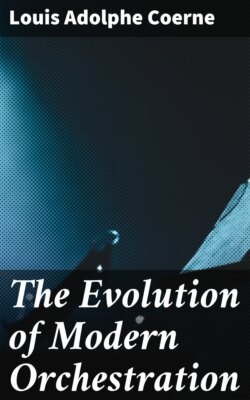Читать книгу The Evolution of Modern Orchestration - Louis Adolphe Coerne - Страница 16
II.
ОглавлениеThe evolution of the harp is obvious, whereas that of the pianoforte is more complex. The prototype of the modern pianoforte in its embryonic state traces its ancestry to all the various types of stringed instruments taken collectively. Specifically, the primitive acoustic monochord of Pythagoras might be looked upon as a plausible starting point. Add to this a keyboard and its attendant devices as applied to church organs in the earlier centuries of the Christian era, and the prototype is complete. Be that as it may, there was developed during the fourteenth and fifteenth centuries a family of widely known instruments embodying advanced qualities of mechanism, styled "Hackbrett," synonym for cembalo, tympanon, although it is best known as the dulcimer. According to Dr. Riemann, it originated apparently in Germany, since for a time it was called in Italy by the name of Salterio tedesco. The instrument consisted of a flat trapezium-shaped sounding-board on which steel strings were set, and was played upon by two hammers held one in each hand of the performer. In improved form, it is still extant in the hands of the gypsies. But already at the beginning of the sixteenth century was the clavichord established as its successor. The clavichord, according to Hipkins, was derived from the polychord with four strings, which in turn was developed from the monochord "to facilitate the melodic division of the Gregorian tones." Directly appeared still another instrument styled clavicembalo or harpsichord, of which the psaltery, a triangular harp, was undoubtedly the ancestor. The spinet and virginal differed from the harpsichord only as to shape; and in England, virginal was the general term for spinet and harpsichord. The cardinal point of dissimilarity between the mechanical construction of the clavichord and the harpsichord was that the strings of the former were caused to sound by means of metal tangents, which struck against the strings and then pressed them up, whereas the strings of the latter were plucked by hard quills set in wooden jacks. But of far greater importance was the difference of tone-quality. The tone of the clavichord was delicate, subdued,—incapable of energetic utterance, but so expressive that it was a favorite with great musicians; that of the harpsichord was crisp, short, uniform. A radical readjustment of mechanism was found necessary in order to combine in one instrument euphony and variation of dynamic force. Therefore in the beginning of the eighteenth century hammer-action was invented, and the pianoforte, derived from the dulcimer, came into existence. Despite this fact, both the clavichord and the harpsichord continued to hold their own beyond the boundaries of that century. And so we see that the perfected modern pianoforte, being but the outcome of a variety of instruments already in existence three hundred years ago, was unable to supersede them until the nineteenth century.
Turning our attention again to instruments belonging to the orchestra proper, we find an inexhaustible subject in the evolution of the two other great families, the wood and the brass. Most of the above-advanced hypotheses in respect to origin and migration of strings are equally pertinent to the wind. But the inference that the genesis of these latter instruments antedates that of the lyre and lute is surely justified in that conch shells and the horns of animals must have offered the most natural means for producing artificial musical tones. Again, the construction of stringed instruments suggests a more advanced stage of intellectuality. Finally, there have been preserved to us from antiquity a far more numerous and varied array of comparatively natural instruments such as the Egyptian mem and sebi,—respectively vertical and horizontal flutes, of which the former was more common and still exists in the guise of the modern Arab flute. One of the most simple species of horn was the "Schofar" or ram's-horn, used in the temple worship of the Hebrews. The Assyrians as well as the Egyptians possessed trumpets, probably of brass. The war trumpets of the Romans were of bronze. The deep-toned trumpet or tuba was straight; the high-toned lituus was bent; and the buccina, large trumpet or trombone, was curved.
